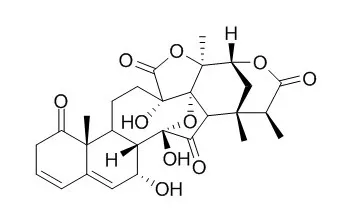Michael reaction acceptors (MRAs) are a class of active molecules that are directly or indirectly involved in various cellular processes, including the regulation of many signaling pathways.
METHODS AND RESULTS:
In this study, the inducible nitric oxide synthase (iNOS) assay was used to demonstrate that the dichloromethane extract of Physalis alkekengi var. franchetii (DCEP) possesses anti-inflammatory activity that might be attributed to the modification of key cysteine residues in IKKβ by the MRAs in DCEP. To isolate these MRAs, glutathione (GSH) was employed, and a simple ultra-performance liquid chromatography/tandem mass spectrometry (UPLC-MS/MS) screening method was developed to investigate the GSH conjugates with potential MRAs. Five physalins, including one new compound isophysalin A (2), together with four known steroidal compounds, physalin A (1), physalin O (3), Physalin L (4) and physalin G (5), were isolated to evaluate the GSH conjugating abilities, and it was indicated that compounds 1, 2 and 3, which had a common α,β-unsaturated ketone moiety, exhibited conjugating abilities with GSH and also showed significant nitric oxide (NO) production inhibiting activities. The anti-inflammatory activities of compounds 1, 2 and 3 might be attributed to their targeting multiple cysteine residues on IKKβ; therefore, the alkylation of IKKβ by compound 1 was further studied by micrOTOF-MS.
CONCLUSIONS:
The result showed that six cysteine residues (C(59), C(179), C(299), C(370), C(412), and C(618)) were alkylated, which indicated that IKKβ is a potential target for the anti-inflammatory activity of physalin A. |






 Cell. 2018 Jan 11;172(1-2):249-261.e12. doi: 10.1016/j.cell.2017.12.019.IF=36.216(2019)
Cell. 2018 Jan 11;172(1-2):249-261.e12. doi: 10.1016/j.cell.2017.12.019.IF=36.216(2019) Cell Metab. 2020 Mar 3;31(3):534-548.e5. doi: 10.1016/j.cmet.2020.01.002.IF=22.415(2019)
Cell Metab. 2020 Mar 3;31(3):534-548.e5. doi: 10.1016/j.cmet.2020.01.002.IF=22.415(2019) Mol Cell. 2017 Nov 16;68(4):673-685.e6. doi: 10.1016/j.molcel.2017.10.022.IF=14.548(2019)
Mol Cell. 2017 Nov 16;68(4):673-685.e6. doi: 10.1016/j.molcel.2017.10.022.IF=14.548(2019)